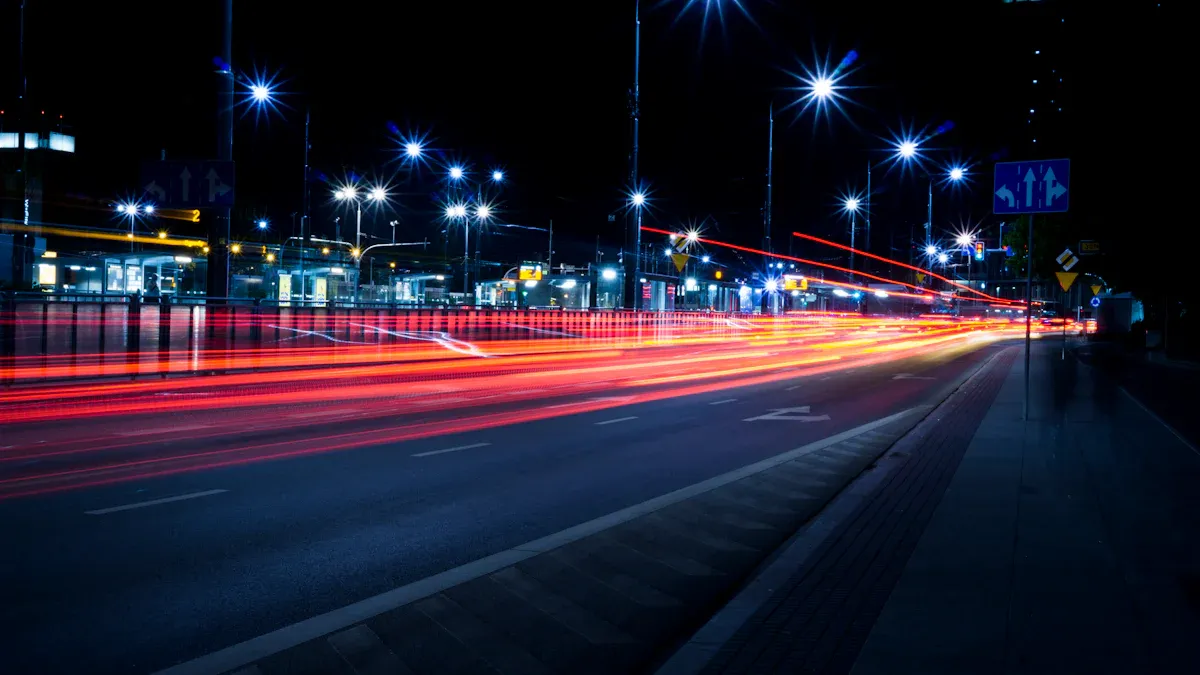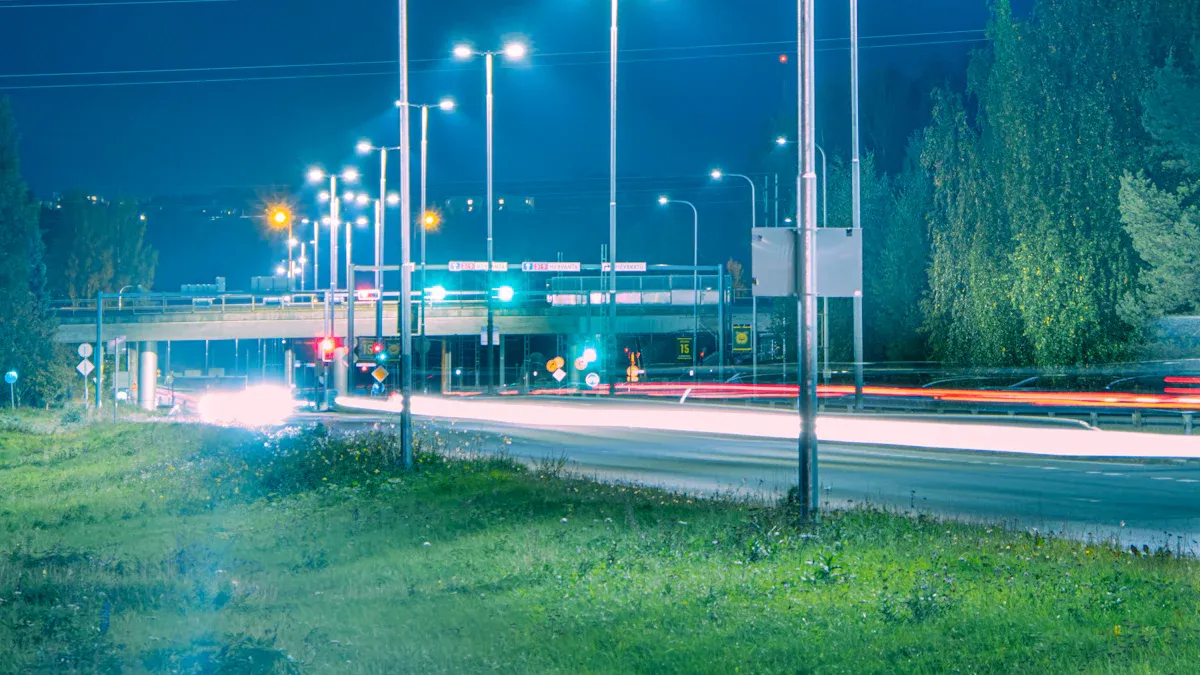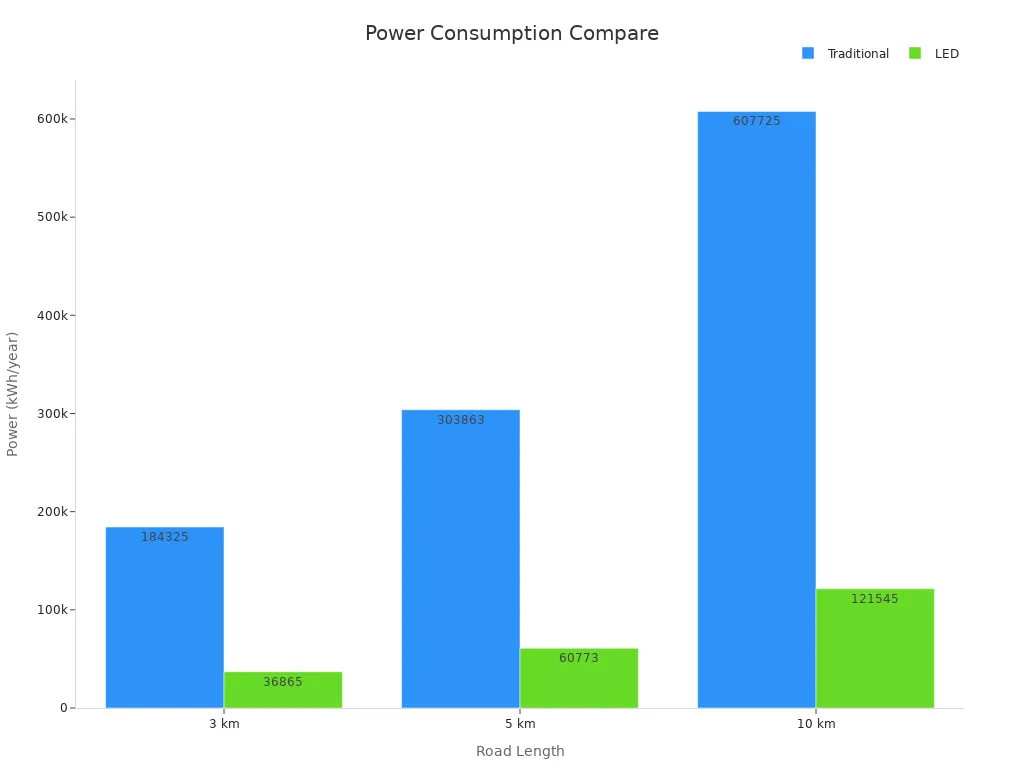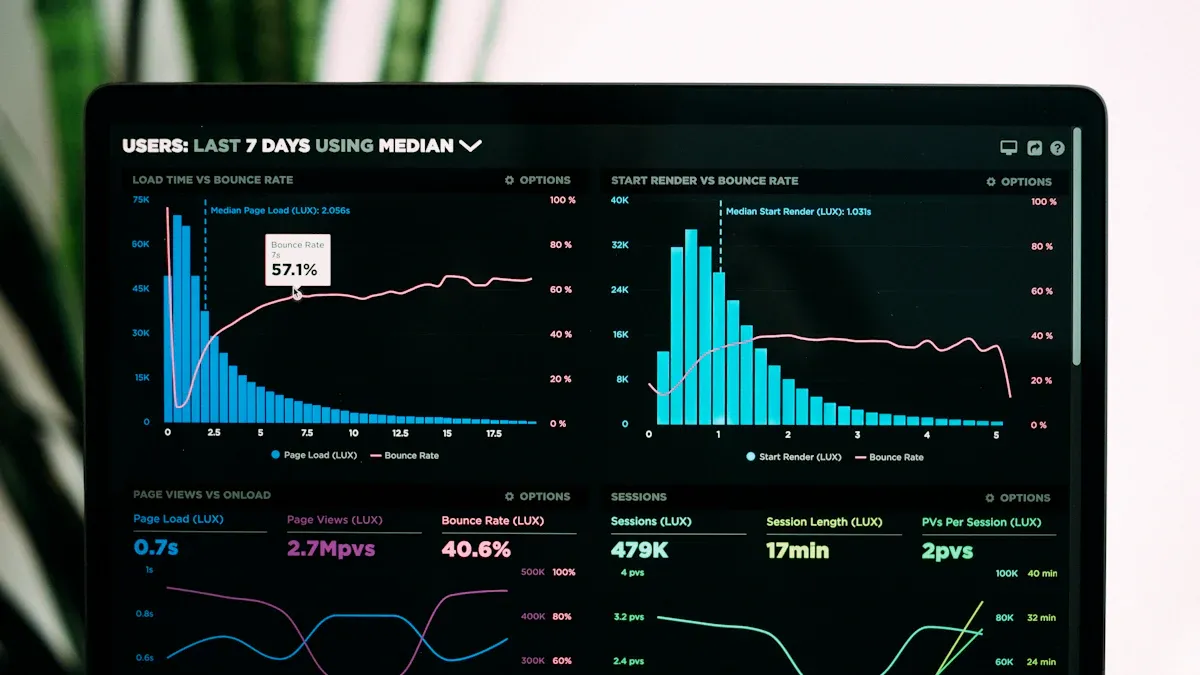LED Streetlights vs Traditional Options: Energy Efficiency and Cost Analysis

When lighting streets, saving energy and money is important. LED streetlights are better in both ways. They use much less electricity than older lights. This helps lower power bills. In 2023, LEDs made up 80% of lighting sales worldwide. Studies say using more LEDs can save billions on energy. They can also lower carbon pollution by millions of tons each year. Picking LEDs saves money and helps the environment too.
Key Takeaways
LED streetlights use up to 80% less energy than old lights. This helps save a lot on electricity bills.
LED streetlights cost more to install at first. But they last longer and need less fixing, saving money over time.
Using LED streetlights cuts carbon emissions. This helps cities protect the environment.
Cities using LED streetlights save money quickly. Energy and repair savings add up fast.
LED streetlights give brighter and clearer light. They make streets safer by reducing dark areas and improving visibility.
Energy Efficiency of LED Streetlights

Power Consumption Comparison
LED streetlights use much less power than older lights. Traditional lights, like mercury vapor or sodium lamps, need more electricity. For example:
Type of Light | Cost (RMB) | |
|---|---|---|
Traditional (3 km) | 184,325 | 184,325 |
LED (3 km) | 36,865 | 36,865 |
Traditional (5 km) | 303,863 | 303,863 |
LED (5 km) | 60,773 | 60,773 |
Traditional (10 km) | 607,725 | 607,725 |
LED (10 km) | 121,545 | 121,545 |
This table shows how LEDs save energy compared to traditional lights. A 250-watt traditional light uses 3 kWh daily, costing $0.36. A 50-watt LED light uses only 0.6 kWh daily, costing $0.07. This means LEDs can save up to 80% on electricity costs.

Efficiency Ratings and Standards
LED streetlights follow strict rules for saving energy. Groups like Energy Star and the International Energy Agency (IEA) set these rules. These rules make sure LEDs use less power but still give good light.
For example, the EN 13201-5 standard helps check how energy-efficient road lights are:
Standard | Description |
|---|---|
EN 13201-5 | Helps check energy efficiency in road lighting setups. |
LEDs are tested carefully to meet these rules. This testing proves they save energy. LEDs give 80 to 100 lumens per watt, while mercury lamps give only 35 lumens per watt.
Impact on Utility Costs
Using LED streetlights lowers electricity bills a lot. They use less power, so costs go down. Lighting a 10-kilometer road with traditional lights costs 607,725 RMB yearly. Using LEDs for the same road costs only 121,545 RMB.
LEDs also last longer, from 50,000 to 100,000 hours. This means fewer replacements and less maintenance. This durability saves even more money over time. Choosing LEDs cuts energy costs and reduces repairs and replacements.
Cost Analysis of LED Streetlights
Initial Costs vs Traditional Lighting
LED streetlights cost more to install than older lights. Installing one LED light costs $2,500 to $3,500. Older HID lights cost $1,500 to $2,500.
Type of Street Light | Installation Cost Range |
|---|---|
HID | $1500 - $2500 |
LED | $2500 - $3500 |
Even though LEDs cost more at first, cities get help. Grants and programs make switching to LEDs cheaper. For example, replacing 100 sodium lamps with LEDs might get a 20% discount. This lowers the cost from $50,000 to $40,000. These programs make LEDs a good choice despite higher starting costs.
Maintenance and Replacement Expenses
LED streetlights need less fixing than older lights. HID or mercury lamps last 5,000 to 10,000 hours. LEDs last much longer, about 50,000 to 100,000 hours. This means fewer replacements and lower labor costs.
LEDs are also tougher against heat, cold, and shaking. They break less often, so repairs are rare. Over time, this saves cities a lot of money on maintenance.
Long-Term Savings and ROI
LED streetlights save more money over time. Cities using LEDs report big savings on energy and repairs. For example:
Los Angeles switched 140,000 lights to LEDs, cutting energy use by 63%.
New York City saves $14 million yearly after switching to LEDs.
A city replacing 10,000 old lights with LEDs can save thousands yearly. Lower energy and repair costs add up fast.
Here’s an example: A city spends $50,000 to replace 100 old lights with LEDs. Energy savings are $20,000 yearly, and maintenance saves $5,000 more. A 20% discount lowers the cost to $40,000. With $25,000 saved each year, the city gets its money back in under two years. The ROI is 62.5%.
Switching to LEDs saves energy and money long-term. LEDs are a smart choice for cities wanting to save and spend wisely.
Environmental Benefits of LED Streetlights

Reduced Carbon Footprint
Switching to LED streetlights cuts down carbon emissions a lot. Older lights use nonrenewable energy, adding to CO2 pollution. For example, in 2021, U.S. power plants made 4.11 trillion kWh of electricity. This caused 1.65 billion metric tons of CO2, or 0.855 pounds per kWh. LEDs use less energy, so they create fewer emissions. They also have advanced optics, giving bright light with less power. Replacing old lights with LEDs helps cities lower their carbon footprint and fight climate change.
Sustainability and Recycling
LED streetlights are better for the environment. They use 50–70% less energy than older lights, reducing harm to nature. LEDs last up to 100,000 hours, meaning fewer replacements and less trash. Recycling is also important for their sustainability. Old LED materials can be reused to make new products, supporting a circular economy. New recycling methods ensure LEDs stay eco-friendly throughout their life.
Type | Energy Efficiency | Carbon Footprint | Cost Over 10 Years |
|---|---|---|---|
Traditional | Low | High | $8,000–$12,000 |
LED | High | Moderate | $4,000–$6,000 |
Choosing LEDs saves energy and helps create a greener planet.
Contribution to Energy Conservation Goals
LED streetlights help save energy and meet conservation goals. They use up to 80% less energy than older lights. Cities like Los Angeles and Amsterdam have seen big improvements. Los Angeles saved 63% energy by switching 215,000 streetlights to LEDs. Amsterdam saved 65% by adding smart controls to their lights. These changes match global efforts to save energy and protect the planet.
Location | Energy Savings (%) | Additional Notes |
|---|---|---|
General | Up to 80% | Compared to traditional lighting systems. |
General | 60–70% | With LED retrofitting and smart controllers. |
Los Angeles | 63% | After converting over 215,000 streetlights to LED. |
Amsterdam | 65% | After deploying smart controls across the city. |
General | Up to 50% | Reduction in maintenance costs. |
Switching to LEDs helps save energy and lowers utility bills too.
Performance and Lifespan of LED Streetlights
Durability and Weather Resistance
LED streetlights are strong and handle bad weather well. They work in heavy rain, snow, and fog without problems. Unlike older lights, LEDs don’t fail easily during storms. Their special covers keep out water, dust, and dirt. These covers meet strict standards, making them tough in hard conditions.
Heat control is important for LEDs to work well. They can get damaged by heat, but smart designs stop overheating. This keeps the materials from breaking down. LEDs also handle being turned on and off often without issues. This makes them great for places needing lights that change often. Even in harsh winters, LEDs stay reliable.
Feature | LED Streetlights | Traditional Streetlights |
|---|---|---|
Weather Resistance | Weak against bad weather | |
Durability | Works well in storms | Often breaks due to wiring problems |
Light Quality and Consistency
LED streetlights give bright and even light everywhere. They have a high CRI (Color Rendering Index) of 80+, showing colors clearly. This helps people see better and stay safe. Older lights, like HPS lamps, have a low CRI of 20, making colors look dull.
LEDs don’t leave dark spots or shadows, making streets safer. They also light up fully right away, which is important for safety. This steady and clear lighting makes LEDs a top choice for cities. They improve how streets look and keep people secure.
Aspect | Evidence |
|---|---|
Light Quality | LEDs have a CRI of 80+, while HPS lamps have only 20. |
Uniform Illumination | LEDs give bright, even light without dark spots. |
Instant Brightness | LEDs turn on fully and instantly, helping with road safety. |
Lifespan Comparison with Traditional Options
LED streetlights last much longer than older lights. Traditional lights, like HPS or mercury lamps, work for 5,000 to 10,000 hours. LEDs, however, can last 50,000 to 100,000 hours. This means fewer replacements and less money spent on fixing them.
Their long life comes from strong materials and smart designs. Good heat control stops them from getting too hot. Their tough covers protect them from weather damage. This makes LEDs a smart and cost-saving choice for lighting streets for many years.
Practical Considerations for LED Streetlights
Challenges in Implementation
Switching to LED streetlights can be tricky. Problems may arise with data accuracy in adaptive lighting systems. For instance:
In Sheffield, changing from HPS lamps to LEDs faced issues due to wrong traffic data.
The Average Annual Daily Traffic (AADF) numbers used were regional, not city-specific. This caused incorrect predictions.
Even after replacing 66,000 HPS lamps with LEDs, energy use stayed high—up to 43.9 billion kWh yearly.
These examples show why careful planning and accurate data are crucial. Without them, energy savings might not meet expectations.
Real-World Examples of Adoption
Many cities have switched to LED streetlights successfully. In the U.S., about 26% of streetlights now use LEDs. Big cities like New York and Milan have fully adopted LEDs, proving large-scale success is possible. Smaller towns, however, often face money problems.
Working together can solve these issues. In southeastern Pennsylvania, 35 towns teamed up to buy LEDs at lower costs. This made switching easier. Globally, Japan and Canada lead with 44-50% LED use, while South America is behind at under 5%. These cases show teamwork and planning help cities switch to LEDs.
Public Perception and Feedback
People mostly like LED streetlights. They enjoy brighter, even lighting that makes streets safer. LEDs also cut light pollution, making stars easier to see in cities. But some worry about harsh light and its effect on sleep.
Cities can fix this by using LEDs with softer, warmer tones. This keeps energy savings while making people comfortable. When done right, LED streetlights can improve life and gain public support.
LED streetlights bring great advantages to cities and groups. They use half the energy, last much longer, and need fewer repairs. This lowers costs and helps the environment by cutting carbon emissions. Their strong build keeps them working well for years.
Switching to LED streetlights is a wise choice. While they cost more at first, they save money over time and give good returns. Focus on these long-term benefits instead of the upfront price to create better, greener lighting for your area.
Aspect | LED Street Lights | Traditional HPS Lamps |
|---|---|---|
Energy Use | Uses more energy | |
Lifespan | Lasts up to 10 times longer | Shorter life span |
Maintenance Costs | Lower due to lasting longer | Higher from frequent fixes |
Carbon Emissions | Much lower | Higher pollution |
Investment Returns | Saves money over time | None |
🌟 Choosing LED streetlights helps make a cleaner, brighter, and more affordable future.
FAQ
Why are LED streetlights better at saving energy?
LED streetlights turn most energy into light, not heat. Older lights waste energy as heat. LEDs also give more light using less power. This means they use less electricity and lower your bills.
Are LED streetlights good for the environment?
Yes, LED streetlights are eco-friendly. They use less energy, cutting greenhouse gases. Unlike older lights, LEDs don’t have harmful stuff like mercury. They last longer, so there’s less trash. Recycling programs make them even better for the planet.
Do LED streetlights need a lot of fixing?
No, LED streetlights don’t need much fixing. They last 50,000 to 100,000 hours, much longer than older lights. They’re tough against bad weather and frequent use. This means fewer repairs and saves money on upkeep.
Why do LED streetlights cost more at first?
LED streetlights cost more because of their advanced design. But they save money later by using less energy and needing fewer repairs. Many cities give discounts or grants to help with the cost, making them worth it.
Can LED streetlights make streets safer?
Yes, LED streetlights make streets safer. They give bright, even light and show colors clearly. This helps drivers and walkers see better. They turn on instantly and reduce dark spots, which can stop accidents and crime.
See Also
Advantages of LED Street Lights: Efficiency, Longevity, and Setup
Modern LED Highway Lighting: Enhancing Safety and Energy Efficiency
Evaluating Commercial LED Bulbs: Costs and Returns for Businesses
Trends in LED Street Lighting: Progress and Innovations Over Time
Choosing Industrial LED Bulbs: Efficiency, Uses, and Best Options

